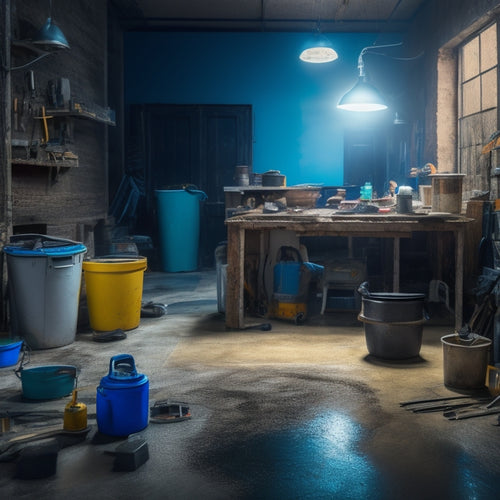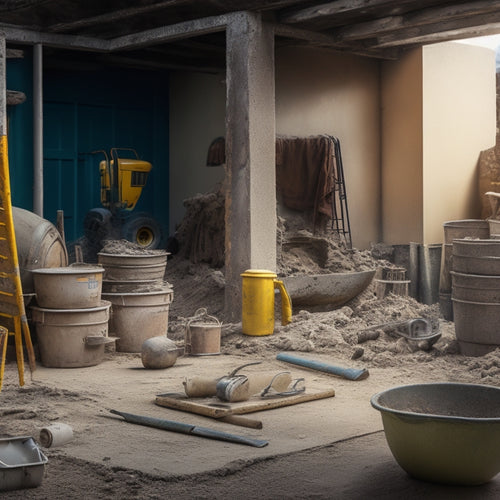
3 Key Tools for Building With Concrete Blocks
Share
You'll need a concrete mixer, a mixing stick, and a measuring bucket to guarantee a solid foundation for your concrete block project, as these three essential tools assure a uniform mix that's strong, durable, and worthy of your building ambitions. A mixer facilitates uniform mixing of cement, sand, and water, while a mixing stick guarantees thorough combination of materials for consistency. Measuring buckets allow for accurate measurement of components in the mix, guaranteeing a reliable bond between blocks. With these three key tools, you'll be well on your way to building a sturdy structure that meets your needs - and there's more to master to take your project to the next level.
Key Takeaways
• A concrete mixer is essential for uniform mixing of cement, sand, and water to ensure consistency in the blocks.
• A mixing stick is necessary for thorough combination of materials and to prevent lumps from forming in the mix.
• Measuring buckets allow for accurate measurement of components in the mix, ensuring the right proportions for strong blocks.
• A spirit level is vital for verifying that blocks are laid evenly and accurately to prevent structural weaknesses.
• A block laying trowel is necessary for precise placement and adjustment of blocks, ensuring a level and plumb structure.
Essential Mixing and Laying Tools
You'll need a set of essential mixing and laying tools to secure a strong and durable concrete block structure. These tools will enable you to achieve the perfect mix and lay blocks with precision, guaranteeing a solid foundation for your project.
For mixing, you'll require a concrete mixer, mixing stick, and measuring buckets to accurately combine cement, sand, and water according to the specified mixing techniques. A mixing paddle or trowel will help you achieve a consistent mix.
When it comes to laying, you'll need a spirit level, string line, and block laying trowel to guarantee accurate and level block placement. A pointing trowel is also necessary for filling gaps between blocks.
By utilizing these tools, you'll be able to implement efficient laying methods, such as the 'buttering and bonding' technique, which secures a strong bond between blocks.
With the right tools and techniques, you'll be able to create a concrete block structure that's both durable and visually appealing.
Block Cutting and Shaping Tools
Cutting and shaping concrete blocks to fit around obstructions or create complex designs requires a specialized set of tools that can handle the block's dense, abrasive nature. You'll need block saws, which are designed to cut through concrete efficiently and accurately. These saws typically feature diamond-coated blades that can withstand the block's hardness.
| Tool | Description | Purpose |
|---|---|---|
| Block Saws | Diamond-coated blades for cutting concrete | Cutting blocks to fit around obstructions |
| Shaping Molds | Precision molds for shaping blocks | Creating complex designs and curves |
| Chisels | Handheld tools for breaking and shaping | Removing excess concrete and shaping blocks by hand |
| Grinders | High-speed grinders for smoothing surfaces | Smoothing out rough edges and surfaces |
When choosing block cutting and shaping tools, consider the project's specific requirements and the type of concrete blocks you're working with. High-quality tools will make the process faster and more efficient, ensuring accurate cuts and smooth finishes. By having the right tools, you'll be able to bring your design vision to life and create complex structures that showcase your creativity and expertise.
Structural Reinforcement and Finishing
As you move beyond cutting and shaping concrete blocks, it's vital to focus on structural reinforcement and finishing techniques that guarantee your construction project meets safety standards and achieves a professional finish.
You'll need to incorporate reinforcing materials like rebar, fiber mesh, or steel fibers to add strength and durability to your structure. Don't forget to apply bonding agents to secure a strong bond between the blocks and the mortar.
When it comes to finishing, you'll want to take into account surface treatments that not only enhance the appearance of your project but also provide protection from the elements.
Apply a coat of waterproofing membrane or a layer of sealant to prevent water infiltration and damage. Additionally, think about using specialized surface treatments like acid etching or staining to achieve a unique aesthetic.
By combining the right structural reinforcement and finishing techniques, you'll be able to create a concrete block structure that's both safe and visually stunning.
With the right tools and techniques, you'll be able to take your project to the next level and achieve professional results.
Frequently Asked Questions
How Do I Prevent Concrete Blocks From Absorbing Excess Water During Construction?
When building with concrete blocks, you'll want to prevent excess water absorption to guarantee structural integrity.
To do this, you'll need to employ effective waterproofing techniques. Start by applying a moisture barrier to the blocks before laying them. This will create a hydrophobic layer that repels water.
Additionally, use a drainage system behind the blocks to direct water away from the structure.
Can Concrete Blocks Be Used for Building a Foundation Below Water Tables?
Imagine trying to build a house on a sinking ship - that's what it's like to construct a foundation below the water table without proper planning.
You must consider water table fluctuations and their impact on foundation stability.
Concrete blocks can be used, but you'll need to apply specialized waterproofing and drainage systems to prevent water seepage and structural damage.
With careful design and execution, you can create a stable foundation that withstands water table variations, ensuring your structure remains secure and durable.
What Is the Recommended Curing Time for Concrete Blocks in Different Climates?
When you're working with concrete blocks, you'll want to confirm proper curing to achieve ideal strength.
The recommended curing time varies depending on the climate. In hot and dry climates, you'll need to cure for at least 7 days, while in cooler and more humid climates, 3-5 days should suffice.
It's crucial to employ effective curing techniques, such as misting or applying a curing compound, to mitigate climate effects and assure a strong, durable structure.
Are There Any Specific Safety Precautions When Working With Concrete Blocks?
As you lift those heavy concrete blocks, imagine the weight of safety on your shoulders.
You're not just building a structure, you're building a safe haven.
When working with concrete blocks, you need to prioritize personal protective equipment like gloves, safety glasses, and a dust mask.
Mastering proper handling techniques, such as lifting with your knees and avoiding twisting, is also essential.
Don't let carelessness crumble your creation - take the necessary precautions to guarantee a strong and safe build.
Can I Use Concrete Blocks for Building Load-Bearing Walls in Seismic Zones?
When building load-bearing walls in seismic zones, you'll need to prioritize seismic design and block reinforcement.
You can use concrete blocks, but it's essential to follow specific guidelines.
Make sure your blocks meet seismic design requirements and are reinforced with rebar or fiber mesh to resist lateral forces.
Additionally, use specialized mortar and grout to enhance the wall's overall strength and durability.
Conclusion
As you put the finishing touches on your concrete block project, it's likely you're feeling a sense of pride and accomplishment.
Coincidentally, the three key tools you used to get there - essential mixing and laying tools, block cutting and shaping tools, and structural reinforcement and finishing tools - are the same ones professionals rely on to guarantee durability and precision.
By mastering these tools, you've not only built a structure, but also a strong foundation for your skills.
Related Posts
-

Must-Have Tools for Laying Concrete Tiles
When laying concrete tiles, you'll need a range of essential tools to get the job done right. Start with subfloor pre...
-

Essential Tools for Epoxy Concrete Floor Repair
You'll need a thorough arsenal of specialized tools to guarantee a successful epoxy concrete floor repair. Floor prep...
-

What Tools Are Needed for Concrete Wall Foundations
You'll need a thorough array of tools and equipment to construct a concrete wall foundation that meets structural int...


